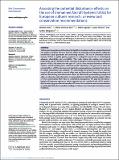Por favor, use este identificador para citar o enlazar a este item:
http://hdl.handle.net/10261/334231COMPARTIR / EXPORTAR:
 SHARE SHARE
 CORE
BASE CORE
BASE
|
|
| Visualizar otros formatos: MARC | Dublin Core | RDF | ORE | MODS | METS | DIDL | DATACITE | |

| Título: | Assessing the potential disturbance effects on the use of Unmanned Aircraft Systems (UASs) for European vultures research: a review and conservation recommendations |
Autor: | Zink, Richard; Kmetova-Biro, Elena; Agnezy, Stefan; Klisurov, Ivaylo; Margalida, Antoni CSIC ORCID | Palabras clave: | Aegypius monachus Disturbance Drones Impact Gypaetus barbatus Gyps fulvus Neophron percnopterus |
Fecha de publicación: | 2023 | Editor: | Cambridge University Press | Citación: | Bird Conservation International 33: e45 (2023) | Resumen: | Vultures are among the most threatened bird guilds on the planet and have a unique functional role within ecosystems. They are therefore subject to increasing research interest, calling for standardised study approaches and monitoring methods. The use of Unmanned Aircraft Systems (UASs) is rapidly gaining popularity in ecological research due to technological advances, affordability, and accessibility. This study reviews the existing peer-reviewed publications and grey literature on the responses of European vultures and other comparable species to UASs, and summarises the types of UAS use, their potential disturbance effects on vultures, and the resulting inter- and intra-specific interactions. Our goal was to assess the potential effects of UASs and to provide practical recommendations to optimise their safe use in vulture conservation and research. We acknowledge the potential of UASs to increase research efficiency and reduce research effort, time, and financial cost. Owing to the absence of sufficient data on long-term disturbance effects, we advocate the precautionary principle and offer a set of species-tailored practical recommendations to limit the potential negative effects of UASs and maximise their value in conservation management. We urge that the physiological and long-term impacts on vulture reproduction are considered and call for standardised monitoring protocols and controls on UAS use. Our conclusions and recommendations are particularly aimed at researchers working on vulture conservation and restoration projects worldwide. | Versión del editor: | https://doi.org/10.1017/S0959270923000102 | URI: | http://hdl.handle.net/10261/334231 | DOI: | 10.1017/S0959270923000102 | E-ISSN: | 1474-0001 |
| Aparece en las colecciones: | (IREC) Artículos (IPE) Artículos |
Ficheros en este ítem:
| Fichero | Descripción | Tamaño | Formato | |
|---|---|---|---|---|
| assessingrecommenda.pdf | 684,74 kB | Adobe PDF |  Visualizar/Abrir |
CORE Recommender
SCOPUSTM
Citations
4
checked on 25-abr-2024
WEB OF SCIENCETM
Citations
3
checked on 23-feb-2024
Page view(s)
25
checked on 27-abr-2024
Download(s)
10
checked on 27-abr-2024
Google ScholarTM
Check
Altmetric
Altmetric
Este item está licenciado bajo una Licencia Creative Commons

